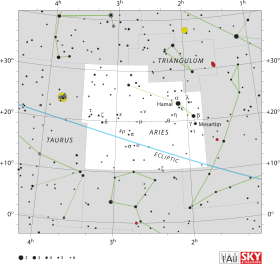49 Arietis est une étoile [ 8] constellation du Bélier . 49 Arietis est sa désignation de Flamsteed . Elle est visible à l'œil nu comme une étoile blanche pâle avec une magnitude apparente de 5,90[ 2] années-lumière parsecs Terre (sur la base de la parallaxe ).
49 Arietis est une étoile Am [ 9] étoile chimiquement particulière [ 10] spectre présente des abondances anormales de certains éléments lourds. Elle a un type spectral kA2hA6mA7, ce qui signifie qu'elle possède la raie K du calcium d'un type spectral A2, les raie d'hydrogène d'une étoile de type A6 et les raies métalliques d'une étoile de type A7. 49 Arietis a un taux de rotation modérément élevé, montrant une vitesse de rotation projetée de 52 km/s et rayonne avec 16 L ☉ photosphère à une température effective de 8 424 K
↑ a b c d e f g h i et j
(en) A. Vallenari et al. Gaia collaboration), « Gaia Data Release 3 : Summary of the content and survey propertiesAstronomy & Astrophysics vol. 674, juin 2023 , article no A1 (DOI 10.1051/0004-6361/202243940 Bibcode 2023A&A...674A...1G arXiv 2208.00211
↑ a b et c (en) T. Oja, « UBV photometry of FK4 and FK4 supplement stars Astronomy & Astrophysics Supplement Series vol. 52, avril 1983 , p. 131–134 (Bibcode 1983A&AS...52..131O ↑ (en) Helmut A. Abt et Nidia I. Morrell, « The Relation between Rotational Velocities and Spectral Peculiarities among A-Type Stars The Astronomical Journal Supplement vol. 99, 1995 , p. 135 (DOI 10.1086/192182 Bibcode 1995ApJS...99..135A ↑ a et b (en) E. Anderson et Ch. Francis, « XHIP: An extended hipparcos compilation Astronomy Letters vol. 38, no 5, 2012 , p. 331 (DOI 10.1134/S1063773712050015 Bibcode 2012AstL...38..331A arXiv 1108.4971 S2CID 119257644 ↑ a et b (en) R. Wielen et al. Sixth Catalogue of Fundamental Stars (FK6). Part I. Basic fundamental stars with direct solutions Veroeffentlichungen des Astronomischen Rechen-Instituts Heidelberg vol. 35, no 35, 1999 , p. 1 (Bibcode 1999VeARI..35....1W ↑ a b et c (en) M. Koleva et A. Vazdekis, « Stellar population models in the UV. I. Characterisation of the New Generation Stellar Library Astronomy & Astrophysics vol. 538, février 2012 , article no A143 (DOI 10.1051/0004-6361/201118065 Bibcode 2012A&A...538A.143K arXiv 1111.5449 S2CID 53999614 ↑ (en) 49 Ari sur la base de données Simbad Centre de données astronomiques de Strasbourg .↑ (en) P. P. Eggleton et A. A. Tokovinin, « A catalogue of multiplicity among bright stellar systems Monthly Notices of the Royal Astronomical Society vol. 389, no 2, 2008 , p. 869 (DOI 10.1111/j.1365-2966.2008.13596.x Bibcode 2008MNRAS.389..869E arXiv 0806.2878 S2CID 14878976 ↑ (en) A. Cowley et al. A study of the bright A stars. I. A catalogue of spectral classifications The Astronomical Journal vol. 745, avril 1969 , p. 375–406 (DOI 10.1086/110819 Bibcode 1969AJ.....74..375C ↑ (en) E. Paunzen et al. A photometric study of chemically peculiar stars with the STEREO satellites - II. Non-magnetic chemically peculiar stars Monthly Notices of the Royal Astronomical Society vol. 429, no 1, février 2013 , p. 119–125 (DOI 10.1093/mnras/sts318 Bibcode 2013MNRAS.429..119P arXiv 1211.1535 S2CID 119231581
Liens externes
Ressource relative à l'astronomie :
